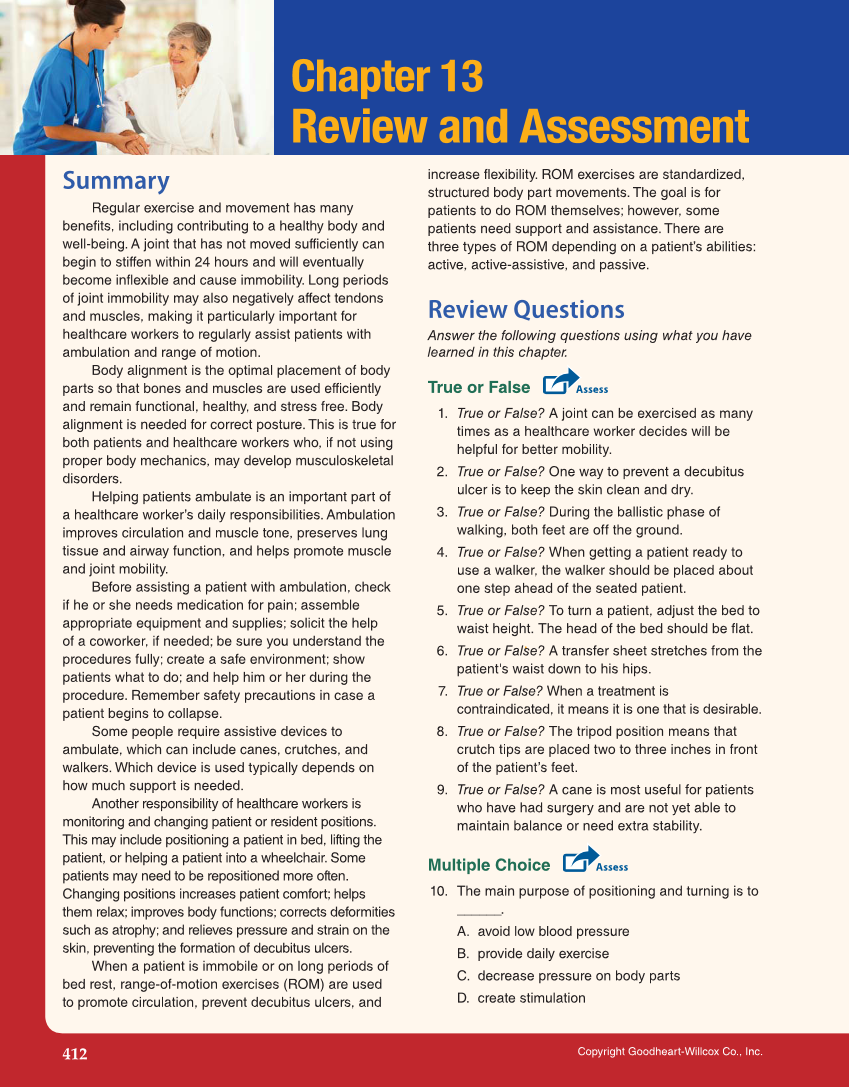412 increase flexibility. ROM exercises are standardized, structured body part movements. The goal is for patients to do ROM themselves however, some patients need support and assistance. There are three types of ROM depending on a patient’s abilities: active, active-assistive, and passive. Review Questions Answer the following questions using what you have learned in this chapter. True or False 1. True or False? A joint can be exercised as many times as a healthcare worker decides will be helpful for better mobility. 2. True or False? One way to prevent a decubitus ulcer is to keep the skin clean and dry. 3. True or False? During the ballistic phase of walking, both feet are off the ground. 4. True or False? When getting a patient ready to use a walker, the walker should be placed about one step ahead of the seated patient. 5. True or False? To turn a patient, adjust the bed to waist height. The head of the bed should be flat. 6. True or False? A transfer sheet stretches from the patient's waist down to his hips. 7. True or False? When a treatment is contraindicated, it means it is one that is desirable. 8. True or False? The tripod position means that crutch tips are placed two to three inches in front of the patient’s feet. 9. True or False? A cane is most useful for patients who have had surgery and are not yet able to maintain balance or need extra stability. Multiple Choice 10. The main purpose of positioning and turning is to ______. A. avoid low blood pressure B. provide daily exercise C. decrease pressure on body parts D. create stimulation Assess Assess Summary Regular exercise and movement has many benefits, including contributing to a healthy body and well-being. A joint that has not moved sufficiently can begin to stiffen within 24 hours and will eventually become inflexible and cause immobility. Long periods of joint immobility may also negatively affect tendons and muscles, making it particularly important for healthcare workers to regularly assist patients with ambulation and range of motion. Body alignment is the optimal placement of body parts so that bones and muscles are used efficiently and remain functional, healthy, and stress free. Body alignment is needed for correct posture. This is true for both patients and healthcare workers who, if not using proper body mechanics, may develop musculoskeletal disorders. Helping patients ambulate is an important part of a healthcare worker’s daily responsibilities. Ambulation improves circulation and muscle tone, preserves lung tissue and airway function, and helps promote muscle and joint mobility. Before assisting a patient with ambulation, check if he or she needs medication for pain assemble appropriate equipment and supplies solicit the help of a coworker, if needed be sure you understand the procedures fully create a safe environment show patients what to do and help him or her during the procedure. Remember safety precautions in case a patient begins to collapse. Some people require assistive devices to ambulate, which can include canes, crutches, and walkers. Which device is used typically depends on how much support is needed. Another responsibility of healthcare workers is monitoring and changing patient or resident positions. This may include positioning a patient in bed, lifting the patient, or helping a patient into a wheelchair. Some patients may need to be repositioned more often. Changing positions increases patient comfort helps them relax improves body functions corrects deformities such as atrophy and relieves pressure and strain on the skin, preventing the formation of decubitus ulcers. When a patient is immobile or on long periods of bed rest, range-of-motion exercises (ROM) are used to promote circulation, prevent decubitus ulcers, and Chapter 13 Review and Assessment Copyright Goodheart-Willcox Co., Inc.
